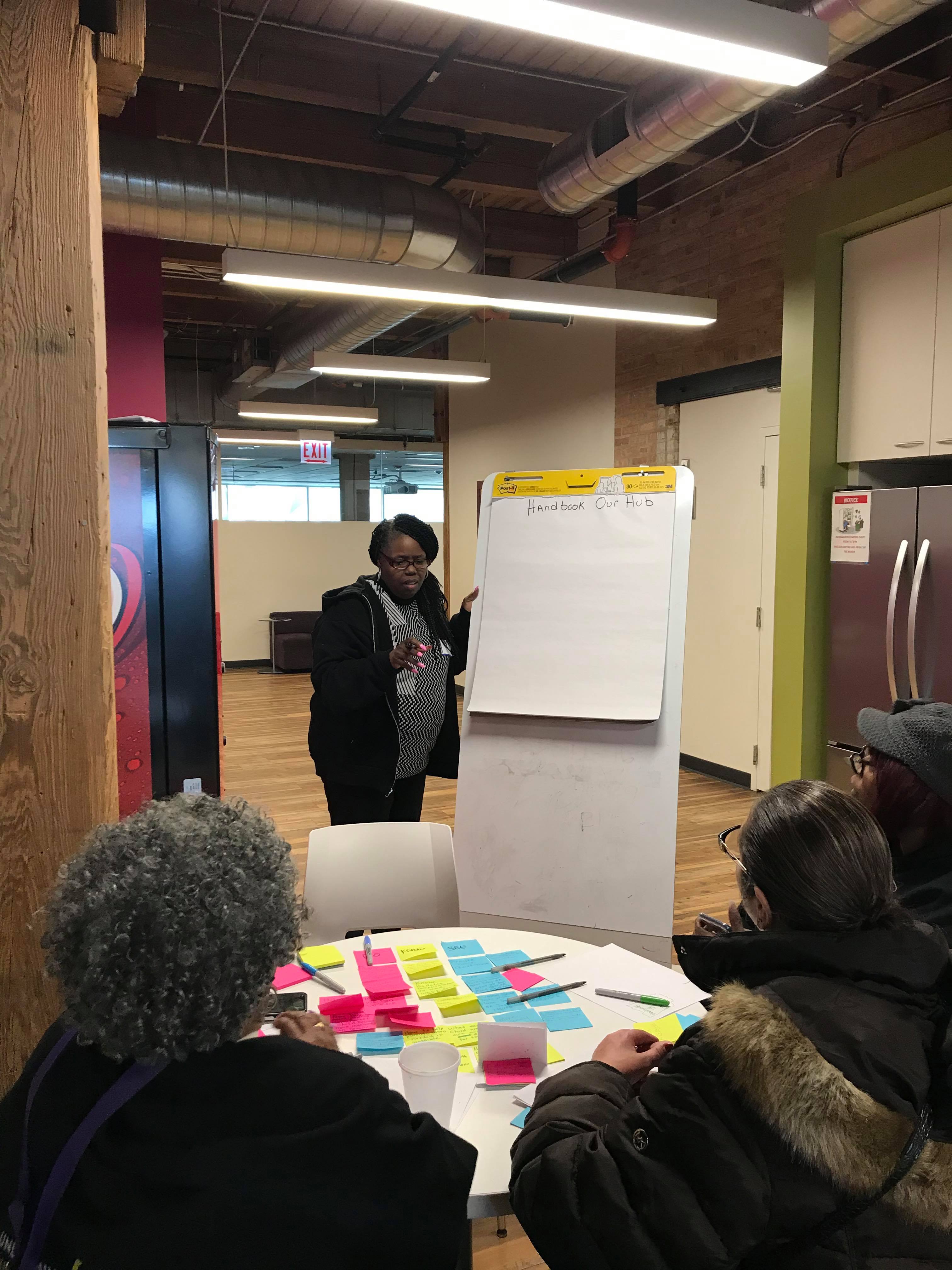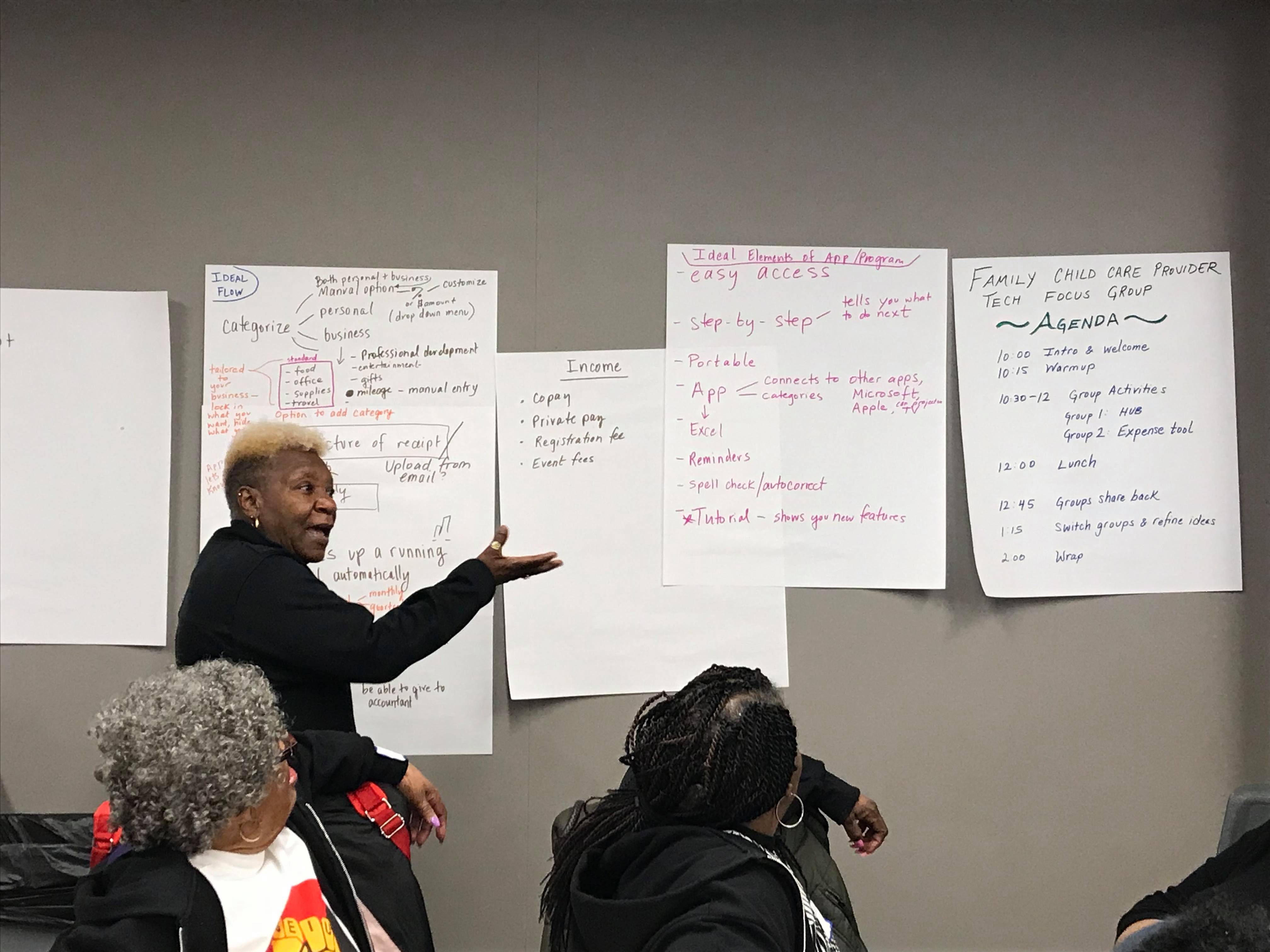Co-designing with Childcare Providers
By Cheryl Li and Dana Ayotte, Inclusive Design Research Centre
2020
Project overview
- The Platform Co-op Development Kit was a project that aimed to build digital tools to help people start, grow, and convert to co-ops. As a part of this project, we did co-design with our partner cooperatives to understand what digital tools they needed.
- This project was in collaboration with the Platform Cooperative Consortium at The New School, and involved the co-design of various tools with members in the co-op community and partner organizations, including CoRise Cooperative.
Our partner
CoRise Cooperative is a childcare provider-owned business. It aims to ease providers’ administrative load and create access to new forms of revenue for greater financial security. Childcare providers, despite being a core pillar of our economy, are overworked and underpaid. CoRise wanted to co-design digital tools that would ease the administrative load of childcare providers.
Desired outcome
- To understand the technology needs of childcare providers
- To build or source existing tools that would meet those needs
Co-design overview
Goals
- Co-design digital tools that would help ease the administrative burdens of the childcare providers
- Co-design digital tools that would improve their work lives in general
Who was there
We had two workshops. Each workshop included:
- Approximately 15 childcare providers
- One community facilitator, who was also a childcare provider
- One or two supporters, who weren’t childcare providers
Co-design process
Community Involvement

A childcare provider leads her small group in outlining their idea for a handbook for childcare providers
- Our team and our partners at CoRise wanted to use a community-led co-design approach from the very start. We asked our partners to find two childcare providers who would work with us to plan the activities, and take lead on facilitating the sessions.
- The community facilitators joined us for the co-design planning sessions. They helped us think through the activities, and ultimately facilitated the sessions.
Planning
- CoRise had worked together with their steering committee (made up of childcare providers) to pick areas of focus for our co-design. Together with our team, we narrowed it down to two areas based on:
- What was the greatest need
- What overlapping needs there were with other project partners. This would allow us to meet the needs of many partners within the limited scope of the project
We started with a list of suggested activities based on co-design sessions we’ve held in the past. We expected that these would only be a starting point for collaboration, and would change to suit CoRise. This list helped CoRise get a sense of what co-design entails.
We then had a discussion with CoRise and the community facilitators about these activities, which helped our team adapt them to suit the project’s specific goals.
Over the span of two or three more discussions, we walked through each activity in detail. Community facilitators gave us feedback on the activities, focusing on:
- whether the scenarios in the activities were realistic
- which activities they thought would work best to achieve their goals
Another goal of these discussions was to help community facilitators understand the activities clearly so that they could confidently facilitate the co-design sessions themselves.
Ideas and Outcomes
In the session, we worked on two distinct ideas that were identified as focus areas together with CoRise:
- A “hub” that would centralize all of their digital tools in one place.

Childcare provider holds up her sketch of her ideal "hub" for centralizing digital tools she needs for her job.
- An expensing tool. We ended up with sketches and user flows for each of these tools.

A childcare provider stands in front of the group, presenting her ideal user flow for an expensing tool.
Challenges and learnings
Scope creep and uncertain timelines
- Due to the limited scope of the project, we tried to identify common needs among all project partners, CoRise being only one of them. We hoped to design tools that could meet some of the needs of all partners. As a result, the co-design process was slow to begin and staggered among all the partners who each had their own scheduling needs. This meant that our timeframe for developing the tools shortened, making it challenging to meet our partners’ needs.
- In retrospect, it may have been better to focus on one or two partners and build something smaller that met their specific needs.
Learning: Set terms of engagement
Agree on goals, scope, and timelines early on in the project. In some cases it can be beneficial to stay flexible and allow things to develop more organically. This also needs to be agreed upon early on in the project, so that all parties can agree to and understand the process.
Related activity: Setting terms of engagement
Learning: Scope to build trust
When a project has limited resources and/or a short timeline, limit the number of communities or partners you are working with. This will help you focus specifically on meeting the needs of that community or organization. This also helps to build trust through realistic planning and goal-setting, and meeting those goals. If many partners or groups are involved in the project, you might consider other ways of organising the project. This can include working with each partner one at a time, or bringing members from different organizations together in shared co-design sessions.
Community facilitators being able to fully participate
- Our community facilitators are busy childcare providers, so the time they had to meet was limited. As a result it was challenging to create conditions where they could fully take part in the collaborative planning process.
Learning: Name and remove accessibility barriers
Come to a mutual understanding of what everyone’s capacities are, and what they would need to fully take part in the process. What may prevent people from participating fully? What are people’s accessibility needs and barriers? How will the group function to ensure that things are accessible as possible?
Related activity: Compensating co-designers, setting terms of engagement
Unlearning who’s an expert and who’s not
- Our community facilitators were often hesitant to give us feedback on the co-design plan. They provided valuable feedback when they felt like the activities we were discussing were in their domain, for example, understanding the context of childcare providers’ lives. However, we also wanted to hear their feedback on whether the activities would be easy to do or would resonate with the providers.
Learning: Demonstrate lived experience as expertise
Try out the activities with community facilitators. This will provide an opportunity for them to apply their lived experience to the activity, to understand that it is valuable, and to see how it can inform the activities and outcomes. This can help to challenge the idea that the designers are the “experts” and know best.
Related activity: Communicating the co-design approach from the start
Learning: Talk about what everyone brings to the table
Before planning, have conversations together about what expertise everyone brings to the table, and how each party wants to contribute to this project.
Related activity: Identify & discuss roles and responsibilities
Impact
Through our co-design sessions, we were able to create:
- Awareness about the process of community-led co-design so that CoRise will be able to continue or repeat it themselves in the future
- Sketches and user flows for two digital tools that CoRise can take forward to further co-design and develop.
- A synthesized list of all the types of tools providers want and need
- Design principles describing how providers like to interact with their digital tools
- A researched collection of existing tools that met their specified needs